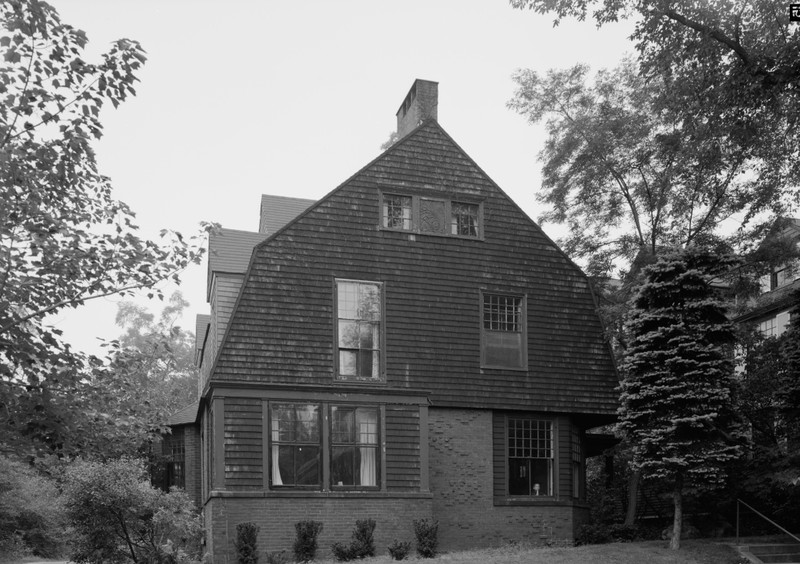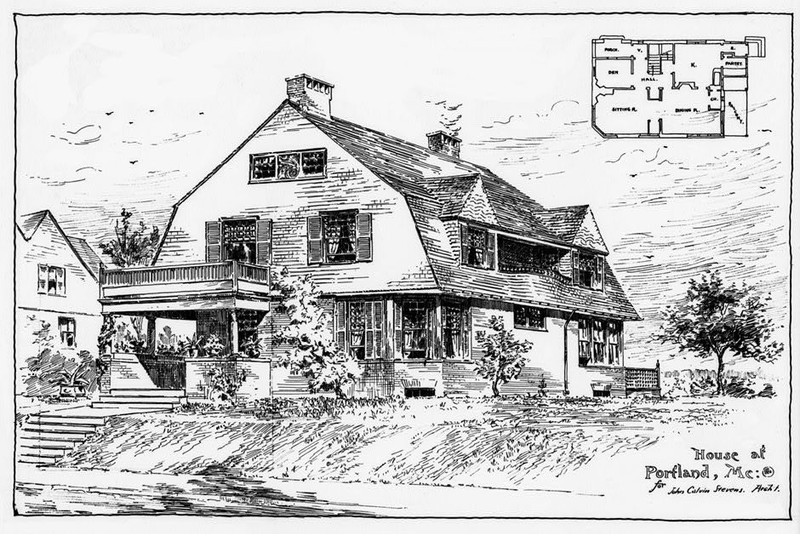The John Calvin Stevens House
Introduction
Text-to-speech Audio
Images
Public domain photograph of the John Calvin Stevens House, Provided by the Library of Congress, Prints and Photograph Division

Perspective drawing of John Calvin Stevens House, 52 Bowdoin Street, Portland, Maine (1883-84), John Calvin Stevens, architect. Published in: Albert Winslow Cobb and John Calvin Stevens, Examples of American Domestic Architecture (1889), plate VII.

Backstory and Context
Text-to-speech Audio
John Calvin Stevens, born in the State of Massachusetts, moved with his family to the City of Portland, Maine at the age of two. After graduating through the Portland public school system, Stevens went on to apprentice as an architect under Francis H. Fassett, another notable architect of the time. In the early 1880s, Stevens travelled back to Massachusetts in the employ of Fassett’s firm. Just two years later, Stevens would leave Fassett’s firm to found his own in back in Portland.
During his time in Massachusetts, Stevens met Albert Winslow Cobb, who would become his partner in business and would work with him to publish Examples of American Domestic Architecture in 1889. In the creation of Examples, Stevens provided the sketches and designs while Cobb handled the writing of the text. Included in Steven’s sketches was a detailed drawing of the house that would later become known as the John Calvin Stevens House.
After the publishing of Examples of American Domestic Architecture and the construction of the John Calvin Stevens House, Stevens would go on to help shape much of the appearance of Portland of the late 1800s. He designed numerous business blocks as well as a number of the most iconic churches in Portland. Some of his most notable works, many of which have also been filed on the National Register of Historic Places, include structures such as the Nathan Clifford School (now Nathan Clifford Residences,) the State Street Church, the L. D. M. Sweat Memorial Art Museum, and portions of the H. H. Hay Building (also known as the Charles Q. Clapp block.)
Stevens’ work with residences, however, would prove to be his greatest legacy, as it helped to spread the growing Shingle style which would come to be iconic both of the region and the era. In the Shingle style, John Calvin Stevens constructed the James Hopkins Smith House, the C. A. Brown House, the First Baptist Church, and more unnamed buildings. These buildings solidified Stevens name as one of the foremost creators of the Shingle style.
The John Calvin Stevens House now stands as one of the most well-preserved historical examples of the Shingle style, having been almost unaltered since Stevens’ final addition to the house in 1905 (which consisted of a library, bedroom, and attic extension.) Of the changes made to the house after Stevens influence, most consist of expanding rooms and/or changing their use. The greatest deviance from his designs is in the addition of two bathrooms to the house, and in the repainting of the siding shingles. In order to preserve the house, the roof was also re-shingled with asphalt.
Aside from these comparatively minor changes, however, the John Calvin Stevens House still maintains incredible accuracy to its original designs, and the interior appears just as it was described in Examples of American Domestic Architecture.
Cite This Entry
Sovis, Emilie. "The John Calvin Stevens House." Clio: Your Guide to History. July 29, 2017. Accessed July 27, 2025. https://theclio.com/entry/43698
Sources
John Calvin Stevens House. Wikipedia.org. Accessed July 27, 2017. https://en.wikipedia.org/wiki/John_Calvin_Stevens_House. Meta-source for general information on the John Calvin Stevens House

